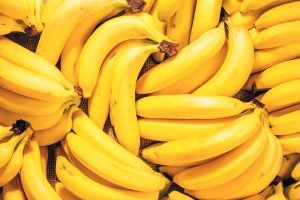We sorely underestimate the contributions of others in the global melting pot. It’s clearly not just Americana. After all, J.K. Rowling (a Brit) brought us the enchantment of Harry Potter, Australia is forever associated with the exploits of Steve Irwin, and Japan mainstreamed the stylings of anime.
On the ag side, biology intertwines with culture, the result of various “exchanges” of crop plants between the Old and New World. Consider the ubiquity of bananas. They’re a worldwide phenomenon — an unparalleled case study in cultural diffusion.
How this modest crop effortlessly insinuated itself into a variety of cultures — all with their own unique spin — is astounding!
Here’s a trivia tidbit about this crop that’s native to Asia and Australia: It’s the world’s largest herb (not an ounce of true wood in those “trunks”). Botanically, the fruit is also a berry.

We delight in its use as a fashionable and functional garnish: a topper on morning corn flakes, or three scoops of ice cream bounded by two lengthwise slabs of yellow flesh, aka the iconic banana split. When they’re past their “use by” date, bananas can even be repurposed into bread — or maybe smoothies or daquiris are more your style.
Despite the name recognition, the much vaunted banana is, ironically, in a pickle.
The vast majority of bananas slated for export are one variety — the Cavendish. It has a great package of traits — seedless, excellent taste, can weather shipping — except for one: its devastating vulnerability to Panama disease, caused by the fungus Fusarium oxysporum f.sp. cubense (Foc). Specifically, tropical race 4 (TR4). This disease gums up the vascular system of the plant, leading to characteristic blackening and clogs of stems when cut and viewed as a cross-section.
So, what’s the issue? Splay the fruit longways and inspect. You’ll note it’s seedless, save for some miniscule specks of poppy-sized, aborted seeds. From a marketing perspective, this is ideal. Generationally, we’ve been conditioned to not even associate “banana and seed” in the same breath. But biologically, its an Achilles heel. No seeds equals no sexual reproduction. A genetic bottleneck — zero genetic diversity. Asexual, vegetative propagation is the only salvation. All Cavendish are clones, and cursed with the same susceptibility.
But the Cavendish is technically “Version 2.0.” This isn’t the first time the banana has been destined for obsolescence. Version 1.0 (the Gros Michel or Big Mike) already was consigned to the history books about 60 years ago. This was due to the same disease, but a different strain (TR1).
So scientists went back to the drawing board and developed the Cavendish.
Have you ever noticed how banana candy is a poor facsimile of the Cavendish? Your taste buds aren’t misaligned. The active ingredient in the candy was synthetically modeled on Gros Michel chemistry. That approximation stood the test of time. Although the actual variety is still grown on small scale, isolated pockets, it’s forever relegated to niche/curiosity status. Interestingly, the Gros Michel was even better adapted for shipping than the Cavendish.
Fast forward to the Cavendish, we’re seeing a recurrence. In an arms race, nature always finds a way to evolve. What started out as “resistance breaking” strain has steadily made its way to most global cultivation hotspots. A number of factors exacerbate the trend toward epidemics: genetic uniformity, large scale production, global trade, fungal lifespan (decades), and a lack/affordability of effective protectants. These factors generally can’t be reigned in without inciting a trade war or otherwise compromising profitability.

So to recap, fungus 4.0 is challenging the viability of banana 2.0. Always a couple of pesky steps ahead. So what’s the solution? Do we need banana 3.0? Or might 2.5 do?
In my view, there’s no need to start from scratch. The template exists, but stepwise tweaks are in order. Enter new breeding techniques, including gene editing and biotechnology.
It’s always said that robust resistance is ground zero in any disease management program. This goes for organic and conventional adherents alike.
If that’s the case, why are we (still) quibbling over “naturalness”? Does natural connote fidelity? Do those who depend on banana as a staple care about how resistance is engineered/imparted if their food security and livelihoods are in urgent danger?
It’s important to remember that bananas are rich in vitamins and nutrients (A, B6, C, potassium, phosphorus, and calcium) and fiber. They’re also reported to have medicinal qualities, improving cholesterol and blood pressure. Moreover, serotonin like compounds in the roots and magnesium in the flowers evidently have anti-depressant properties. It’s a potential bounty to explore, if we can mobilize the resources and dispense with the incessant (and baseless) shrieks of “GMO”.
Splicing a gene from a related banana confers resistance. Is that genetically “close enough” to appease cynics? Another approach is to silence specific fungal genes (on the plants end) so the disease can’t get spun up in the first place. Basically, the plant comes across as a standoffish and incompatible host. In the Philippines, a gene-edited, non-browning banana was recently approved by regulators. It also happens to exhibit resistance.
For maximum resiliency, why not stack all these approaches? While we’re at it, enhance the nutritional (neutraceutical) profile. End product, not process-based outcomes. At a national level, it’s a matter of convincing regulators to not capitulate to the most vocal (problem-fixated) naysayers. Appropriate framing, showcasing, and negotiations then need to diffuse across borders to permit free trade of timely innovations.
I’m hopeful that ethic can foster banana “version 2.5”. Otherwise, it’s back to the drawing board, as natural selection demands.
There’s an additional complication. Another fungus — an entrant named Black Sigatoka — is ascending the disease hierarchy. Time for some transnational ventures, preferably in the public domain, to soundly rebuke critics.
Tim Durham’s family operates Deer Run Farm — a truck (vegetable) farm on Long Island, New York. As an agvocate, he counters heated rhetoric with sensible facts. Tim has a degree in plant medicine and is an Associate Professor at Ferrum College in Virginia.



